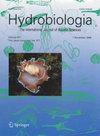异养生物对墨西哥太平洋边缘珊瑚礁次生钙化的贡献
IF 0.3
4区 生物学
Q4 MARINE & FRESHWATER BIOLOGY
引用次数: 0
摘要
背景。坚硬生物(如钙质藻类、苔藓虫、多毛类、软体动物和藤壶)产生礁状碳酸钙(CaCO3)。它们的贡献是维持正CaCO3平衡的关键,尤其是在边缘珊瑚礁。目标。比较墨西哥太平洋两个边缘珊瑚礁:Zihuatanejo Guerrero湾的Las Gatas (LG)和Bahía de Los Angeles(加利福尼亚湾)的La Llave (LL)的结块产生的CaCO3。方法。在6个月和15个月的两次部署期间,使用CAUs(钙化/增积单元)来促进硬化招募。结果。钙化率在6个月时很高,然后由于快速定植和初始生长而降低,随后随着时间的推移而降低。在LG沉积1.2±0.4 kg CaCO3 m-2年-1,占墨西哥南太平洋分支珊瑚产量的7% (17.2 kg m-2年-1),而在LL沉积2.1±0.7 kg CaCO3 m-2年-1;相当于该地区大型珊瑚产量的20% (10.1 kg m-2 year -1)。沉积caco3最多的类群是LG的软体动物和苔藓虫(最多0.65±0.16 kg m-2年-1)和LL的藤壶(最多2.32±0.35 kg m-2年-1)。结论。这些结果强调了异养生物作为次生钙化剂的作用,无论是在受人为活动影响的LG地区,还是在与上升流相关的低人为影响但高生物生产力的LL地区。这一发现表明,研究地点的环境条件限制了初级钙化物(即珊瑚和CCA)的钙化,但促进了次级钙化物的钙化,具有潜在的地貌影响本文章由计算机程序翻译,如有差异,请以英文原文为准。
Contribution of heterotrophs to secondary calcification in marginal reefs of the Mexican Pacific
Background. Sclerobionts (e.g., calcareous algae, bryozoans, polychaetes, mollusks, and barnacles) produce reef calcium carbonate (CaCO3). Their contribution is key to maintaining positive CaCO3 balances, especially in marginal reefs. Objective. To compare the production of CaCO3 by sclerobionts in two marginal reefs of the Mexican Pacific: Las Gatas (LG), in Zihuatanejo Guerrero Bay, and La Llave (LL), in Bahía de Los Angeles (Gulf of California). Methods. CAUs (Calcification/Accretion Units) were used to promote sclerobiont recruitment during two deployment times: 6 and 15 months. Results. The calcification rate was high at six months and then decreased due to rapid colonization and initial growth, followed by a decrease over time. Sclerobionts deposited 1.2 ± 0.4 kg CaCO3 m-2 yr-1 in LG, which represents 7% of the production of branching corals in the Mexican South Pacific (17.2 kg m-2 yr-1), while in LL, they deposited 2.1 ± 0.7 kg CaCO3 m-2 yr-1; equivalent to 20% of the production of massive corals in the area (10.1 kg m-2 yr-1). The groups that deposited most CaCO3were mollusks and bryozoans in LG (up to 0.65 ± 0.16 kg m-2 yr-1) and barnacles in LL (up to 2.32 ± 0.35 kg m-2 yr-1). Conclusions. These results highlight the role of heterotrophs as secondary calcifiers both in LG, a site impacted by anthropogenic activity, and in LL, an area with low anthropogenic impact but high biological productivity associated with upwellings. This finding implies that the environmental conditions at the study sites limit the calcification of primary calcifiers (i.e., corals and CCA) but promote that of secondary calcifiers, with potential geomorphic repercussions
求助全文
通过发布文献求助,成功后即可免费获取论文全文。
去求助
来源期刊

Hidrobiologica
生物-海洋与淡水生物学
CiteScore
0.40
自引率
0.00%
发文量
8
审稿时长
>12 weeks
期刊介绍:
HIDROBIOLÓGICA es una publicación cuatrimestral que difunde trabajos originales e inéditos de investigación o revisión, sobre temas relacionados con los organismos y la hidrología de los ambientes acuáticos, dulces y marinos y va dirigida a investigadores de todo el mundo, interesados en las diversas disciplinas que incluye la Hidrobiología , así como a alumnos de posgrados y licenciaturas relacionados con la biología, ecología, taxonomía, filogenia y evolución de organismos acuáticos, e hidrología y oceanografía de ambientes s dulceacuícolas y marinos.
 求助内容:
求助内容: 应助结果提醒方式:
应助结果提醒方式:


